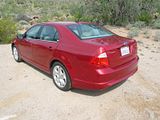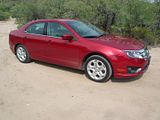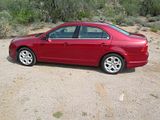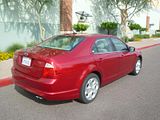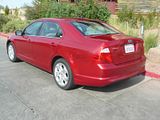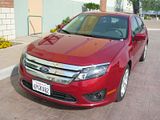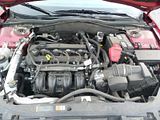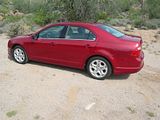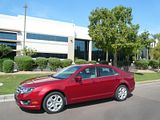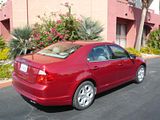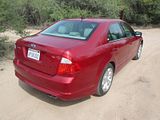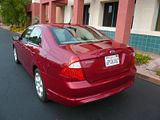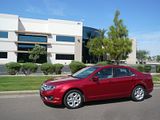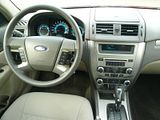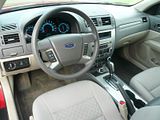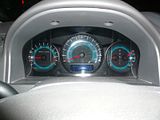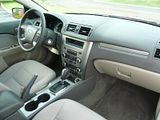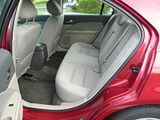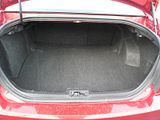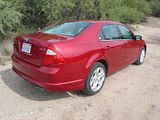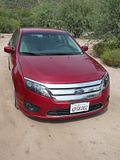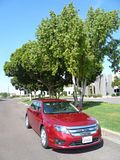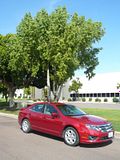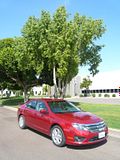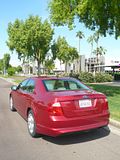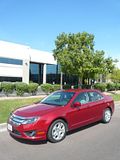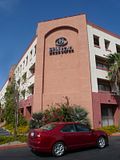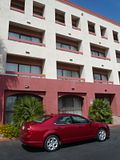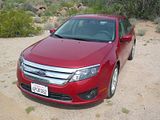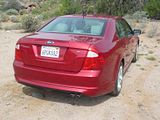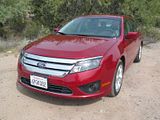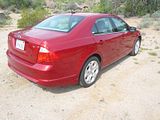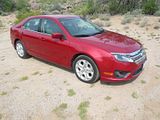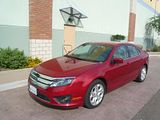
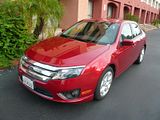
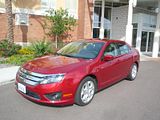

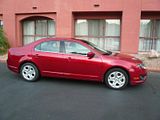
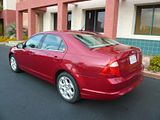

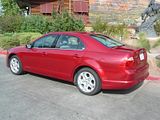
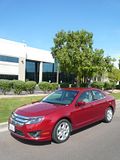
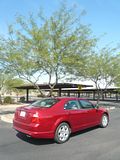
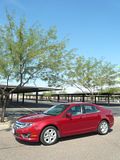
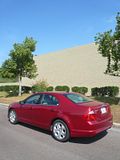
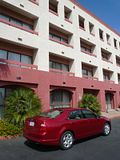
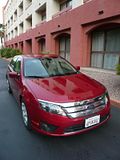


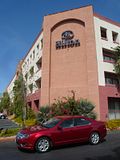
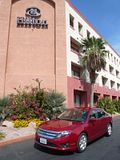
Although I have previously driven an early model Fusion, as well as its close relatives the Mercury Milan and what was initially called the Lincoln Zephyr, they all featured the 3.0 V6 engine, so this was the first time I got to try one of these cars with the 4 cylinder engine. Ford upgraded their offering to a 2.5 litre unit in 2010, in an attempt to address previously expressed concerns that the old 2.3 litre unit was neither powerful nor refined enough compared to the competition. It develops 170 bhp, which is right in the heart of the sort of number that you will find produced by all its competitors. It gets the job done, and no more, now. It is actually decently smooth and refined, but to get much in the way of acceleration, you will have to work it quite hard, at which point it ceases to be quite the same refined unit you might have thought it was. Standard transmission is a 5 speed manual, but like all rental cars, the test vehicle came with the 6 speed automatic which was very smooth in operation. There are no column paddles, and not even a manual mode on the gear lever itself. The trip computer told me that I averaged 31.3 mpg US but when I divided the number of miles I had driven by the amount of fuel I put in the tank, it came to 30.555 mpg US (which is 36.5 mpg Imperial), suggesting perhaps the car went back a little more genuinely full than when I got it. Whatever, that is a good result, though the Fusion did not have to endure any significant urban crawl, or that much freeway cruising, so it did have quite a gentle period in my custody. My biggest surprise, and disappointment with the Fusion was the steering. I recalled that the Milan had a very nice, precise, well weighted system. Sadly, that was not the case with the Fusion. It was too light, vague and felt sloppy around the dead ahead position. It did get a little better the more you turned the wheel, but unlike almost all modern Fords, this one will win no prizes for steering feel. Whether it was a reflection of the fact that this was a well-worn rental car with nearly 20 months and 39,000 miles of abuse (but good looking tyres), whether it is a feature of the 4 cylinder cars with their lighter front end compared to the V6s, I cannot tell based on a sample size of one, sadly. All I can report is what I found, and that I was disappointed.
SE models have a plastic moulded steering wheel, and while it is less unpleasant than many of its type, there is no doubt that leather is infinitely preferable. Although the steering was a let down, the handling was better, though you would struggle to call this car fun to drive. I guess for a family saloon, that is perhaps not the point, though if a manufacturer is looking for a class USP, I would submit that is the one to aim for, as almost all the protagonists have covered most of the other bases and come up with broadly similar results. No issues with the ride on Arizona’s mostly excellent smooth surfaces, though a few hard ridges did cause momentary judder, but I suspect that all cars would have struggled with those. The brakes were fine, too, needing just the right amount of pressure to bring the Ford to a stop. A conventional pull-up handbrake is located between the seats. This Fusion had Ford’s very simple solution to elimination of blind spots. No complex electronic warning systems are involved, but simply the use of a second mirror in the top corner of each door mirror giving a different perspective on what is coming up behind you. I first came across this in the outgoing Escape model, where it worked well, and it was equally effective here. Without it there would be something of an issue as the main mirrors are not that wide, so there would otherwise be occasions when there was a vehicle almost alongside which you would not be able to see.
It was dark when I picked up the Fusion, so the first real view I got of the interior was when I turned on the ignition and I was greeted by a rather distinctive blue/turquoise glow to the instruments. Unlike the Mustang where you can cycle through a whole palette of different colours, this is your only choice in this car, but it is certainly different, and surprisingly agreeable. Even in the daylight, as I found out the next morning, the blue hue is quite evident. When the Fusion and its close relatives were first debuted, the standards of interior design, fit and finish were a notable improvement on almost anything else available in its class, but that was in 2005/6 and the game has moved on considerably since then. Unlike recent many Fords which manage to look cheap and tawdry with their over-stylised mess of surfaces, buttons and gewgaws not all of which work as well you would like, there is a refreshing simplicity to this one. The instrument cowl covers three dials, with fuel level and water temperature combined in the right hand of the three. All the instruments are clearly marked and easy to read. The graphics used for the digital display of odometer and trip computer data are one of the age give-aways as they look like they came from the 1990s not the twentyfirst century with their old style simple green displays. You cycle between the trip computer data points by pressing the left side of one of the many buttons on the left hand side of the steering wheel boss The top of the central part of the dash has a large but fairly shallow cubby on it, and then there are a pair of air vents which were much needed when the temperature soared to well over 100 degrees. The central part of the dash contains the integrated audio unit, which I was pleased to discover included a (working) satellite radio function. Air conditioning controls are set beneath this. Two chunky column stalks operate the indicators and wipers, and the lights are driven by a rotary dial on the dash to the left of the wheel. There are a row of buttons on either side of the steering wheel boss, those on the left for audio functions, those on the right for cruise control. The whole ensemble is quite neatly presented, though it does look a little old-fashioned (if you liked simple, that might be a good thing!). It is made of reasonably soft plastics, and like the rest of the cabin is presented in two shades of grey.
Stung by criticism that the Fusion’s predecessor, the Contour and Mystique, were too compact with insufficient room inside them, Ford did not make the same mistake with this car, and indeed passenger accommodation is perfectly adequate. There is ample legroom in the back, even when the front seats are set well back. When they are set for my driving position, there is an acre of space. Headroom should not be a problem either, and there is enough width to accommodate three adults across the back seat without too many grumbles. There is a good sized boot, though there is no external release, so you either need the key, or to press the release on the key fob or the button on the dash to get in there. It is of a generous size, with good width, depth and length and should accommodate four people’s luggage quite easily. The rear seat backrests can be folded forward to create more space if required. Inside the cabin, as well as the shallow tray on top of the dash, there is a modest glovebox, door bins with a moulding to secure a bottle, a deep cubby under the central armrest and a small area in front of the gearlever for those odds and ends. Rear seat passengers get door bins and map pockets in the back of the front seats.
The test car was in SE spec, which is off the bottom of the stack, but only just, sitting above the S, but below the SEL and Sport models in the range. All Fusion get standard air conditioning, cruise control, an AM/FM audio unit with CD and MP3 capability, a tilt and telescopic steering wheel, centre armrest and cubby and (apart from the Hybrid model) folding rear seats. The SE adds an 8 way power adjustable driver’s seat, satellite radio with steering wheel controls, illuminated visor mirrors, automatic headlights, fog lights and 17″ wheels. Upgrade to an SEL, and you get standard automatic transmission, leather wrapped steering, heated leather seats with power adjustment for the passenger seat, a compass, the keypad entry system and a USB port for the audio unit. The Sport model is based on the SE trim, and is really all about the 3.5 litre engine, but you do get a rear spoiler, leather seats with 10 way power adjustment for the driver’s chair and the compass. The Hybrid model is trimmed to similar levels as an SEL. List price for the SE model is $21,850, which is $2000 more than the entry level S car. The SEL costs a further $3450 and an AWD Sport comes in at $29,000.
In the past, the versions of this car that I have driven have impressed me as being among the best in class. Whilst this Fusion struck me as perfectly competent, if rather inoffensive, I concluded that in 2012 it must be viewed as a Good Car that has become Old. That is OK, because within a couple of weeks the all new Fusion, with its Aston-Martin apeing grille goes on sale in America, and the early reviews suggests that it could be a very good car indeed. I am sure that it will appear in the rental fleets before long, so doubtless in 2013 I will get the chance to find out for myself what it is like. Meanwhile, if you are offered a Fusion of this generation as your rental vehicle, you could do worse. Far worse.


